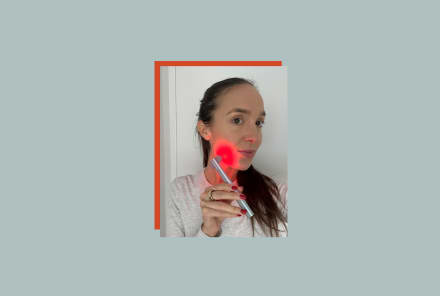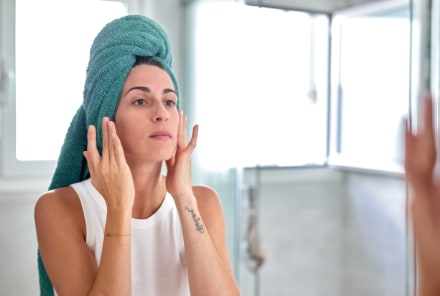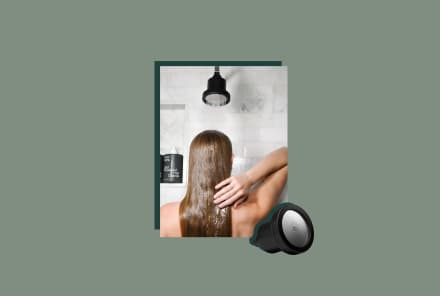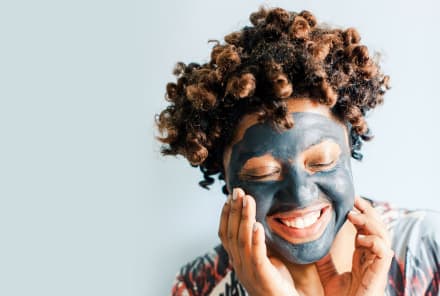Advertisement
Yes, Your Skin Atrophies & Becomes Crepey With Age — How To Treat It

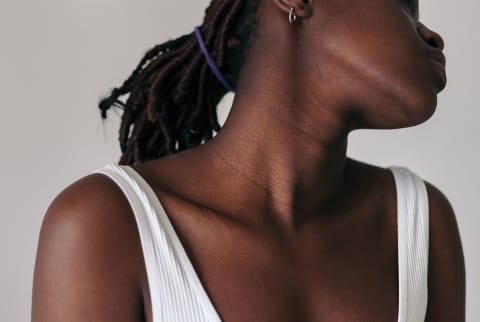
I have fairly thin skin—and, unfortunately, I mean that both literally and figuratively. I'll spare you an essay on my sensitive nature and rather go straight to the literal aspect: my attenuated complexion.
The thinness of my skin is apparent in all the obvious ways: My veins show through not just normal spots (like the forearms or back of the hands) but even places like my legs and chest. The skin under my eyes is sallow and so transparent that I have dark-purple-tinted circles constantly. My chest has begun to appear crepey and develop fine lines prematurely. I bruise at the slightest provocation.
My skin has always been this way, and for the most part I've accepted its appearance (and use a good helping of concealer to hide those ever-present dark circles). What gives me pause, however, is what will happen as I age—because the hard truth is that skin often thins over time.
Thick vs. thin skin: What's more beneficial to your overall health & appearance?
There are a lot of misconceptions about how thick or thin your skin should be. For example, folks are often encouraged to exfoliate in order to slough off layers of dead skin cells, thereby thinning it out. And in the same vein, having thickened skin, such as calluses, is often considered unsightly.
The truth is much more nuanced than that, so let's first have a skin anatomy lesson: The skin is made up of several layers1. The two main layers discussed in skin care are the epidermis and dermis. The epidermis is thin—it's only approximately 0.7 - 1.5 mm in thickness2. Despite its waiflike structure, it's further composed of several more layers, including the outermost stratum corneum. This layer is made up of dead keratin, and it's what gets exfoliated during skin care routines. Within reason, it can be very beneficial to occasionally thin out this layer.
Then there's the dermis, which is the middle layer of the skin that contains all of your skin's connective fibers, structural proteins, and other extracellular components. This layer is incredibly important for keeping skin structure firm, smooth, and vibrant. Much of what we do in skin care and aesthetics is to support this layer—such as encouraging collagen and elastin production and protecting the skin from oxidative damage.
The dermis is the layer we actually want to be thick—so of course, this is the layer that actually wears down and atrophies. (Life is so unfair, no?) So when I say the skin thins with age, what I mean is that the dermis thins with age.
Yes, you read that right: The skin can thin & atrophy
Atrophy is such an ugly word—even just saying it sends shivers down my spine. The definition is even more bone-chilling: Atrophy means to "waste away" and "gradually decline in effectiveness due to underuse or neglect." Someone call A24 because that is some horror-level verbiage!
Atrophy is most commonly used in relation to muscle health. For example, sarcopenia (from the Greek sarx, "flesh," and penia, "poverty") describes the rapid loss of muscle mass and function—or muscle atrophy. Or most folks have heard of bone density loss, commonly called osteoporosis. But those two aren't the only organ systems of the body that weaken.
"Fundamentally, there are biological processes that lead to skin, muscle, joint, and bone aging. In terms of bone, most people have heard of the term osteoporosis. Well, for skin there's a new term called dermatoporosis that's basically the same concept, which is chronic cutaneous insufficiency or fragility," board-certified dermatologist Anar Mikailov, M.D., tells me during an episode of Clean Beauty School. "About 40% of individuals in their 60s and over will have some manifestation of this, and these manifestations can be both visual and functional."
Mikailov knows a thing or two about skin aging and appearance—as he co-authored a textbook on it, Fitzpatrick's Color Atlas and Synopsis of Clinical Dermatology, Ninth Edition. He's also the founder of Skintensive and KP Away, both dermatological skin care brands that target specific skin concerns such as bruising, keratosis pilaris, atrophy, and so on.
We actually have a word to describe skin atrophy in the beauty space: "My patients will often refer to it as maybe crepey skin, but it's just skin that is much, much, much thinner," he says. It's a fairly apt description, as thin, depleted skin can appear crinkly, thin—much like crepe paper.
What to do about skin atrophy—aka crepey skin
"Skin 'crepiness' is commonly used to describe aging skin that has lost elasticity, appearing thinner and more fragile, often with wrinkles," board-certified dermatologist, dermatologic surgeon, and founder of Spectrum Skin and Laser Jeremy Brauer, M.D., tells us about crepey skin.
As noted, it comes as the result of a thinning dermal layer, which is the layer of the skin made up of collagen and elastin. So one of the best ways to support thinning skin is to address its root cause: collagen loss.
Collagen declines due to a variety of reasons, such as UV exposure, free radical damage, inflammatory diet, restrictive diets (especially insufficient protein), stress, lack of sleep, and irritating topical products. To protect collagen, it's important to address any lifestyle factors that could be contributing to its destruction.
But you should also protect it topically, namely with sunscreen, antioxidants, and soothing hydrators.
Sunscreen
This is the most important step in ensuring you keep collagen protected. UV exposure does a number on the skin—it's the no. 1 contributor to skin aging, after all. Find a sunscreen that agrees with your skin type, blends in effortlessly with your skin tone, and that you enjoy the experience of—that'll help ensure you actually apply it daily.
Outside of just sunscreen, we recommend practicing safe sun care overall: Wear hats and protective clothing when spending time outdoors, avoid peak sun hours, and don't sunbathe for sport.
Antioxidants
No matter your skin concern, antioxidants are your friend. Antioxidants neutralize free radicals, which wreak havoc on the body. And unfortunately, we are bombarded with free radicals on a daily basis, due to the normal metabolic process but also pollution, diet, stress, and overall inflammation.
Utilize skin care products that are chock-full of them. Look for vitamins C and E, coenzyme Q10, polyphenols, niacinamide, and panthenol—which are all common antioxidant additions to skin care products. You can also utilize antioxidant-rich botanical extracts, such as shea butter, coconut oil, moringa seed oil, aloe vera, and so on.
Plumping hydrators
One of the best ways to ease the appearance of thin, crepey skin is to plump up the skin with hydrators. As board-certified dermatologist Hadley King, M.D., told us, "Moisturize, moisturize, moisturize—this can improve the appearance."
Look for lotions that flood the skin with hydration from multiple sources, such as humectants, emollients, and occlusives. Working together, these types of hydrators can help the skin remain moisturized for longer.
Humectants pull in and attract water—opt for options such as hyaluronic acid, aloe, and glycerin. Emollients nurture and support the moisture barrier—look for ceramides, peptides, fatty acids, oat extracts, and botanical oils. And finally, occlusives create a seal over the skin, trapping moisture in. Thick, waxy ingredients such as butters, plant waxes, and thick oils will do the trick.
The takeaway
Dealing with thinning skin—especially when your skin is thin to begin with—is frustrating. But it helps to know why it's happening and how you can effectively address it: Skin thinning is the result of collagen loss in the dermal layer, so to address it you need to go to the source: collagen production. From there, support the skin by protecting it from UV damage, fighting off free radicals, and loading the skin with plumping hydration.
Watch Next
Enjoy some of our favorite clips from classes
Enjoy some of our favorite clips from classes
What Is Meditation?
Mindfulness/Spirituality | Light Watkins
Box Breathing
Mindfulness/Spirituality | Gwen Dittmar
What Breathwork Can Address
Mindfulness/Spirituality | Gwen Dittmar
The 8 Limbs of Yoga - What is Asana?
Yoga | Caley Alyssa
Two Standing Postures to Open Up Tight Hips
Yoga | Caley Alyssa
How Plants Can Optimize Athletic Performance
Nutrition | Rich Roll
What to Eat Before a Workout
Nutrition | Rich Roll
How Ayurveda Helps Us Navigate Modern Life
Nutrition | Sahara Rose
Messages About Love & Relationships
Love & Relationships | Esther Perel
Love Languages
Love & Relationships | Esther Perel
-v1646695196476.jpg?1148x800)



